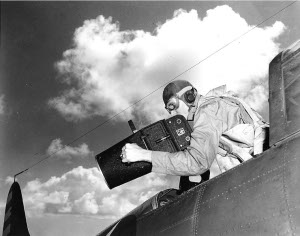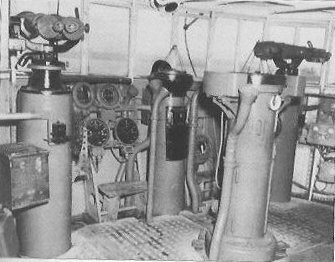![]() The Pacific War Online Encyclopedia
The Pacific War Online Encyclopedia
|
| Previous: Ream Field | Table of Contents | Next: Reconnaissance Aircraft |

National
Archives #80-G-416837
Reconnaissance is the military art of obtaining intelligence on the enemy through direct observation. The ideal reconnaissance mission gathers detailed information on enemy dispositions without being detected, but this is not always possible. During the Pacific War reconnaissance was carried out by land, sea, and air forces.
Reconnaissance by land forces is typically carried out by infantry patrols. An infantry patrol is essentially a party of soldiers sneaking around in front of their own lines in an effort to spot enemy positions before the enemy spots them. It is one of the more difficult military skills to master, and it is a mark of green troops that they conduct few and unaggressive patrols.
To supplement the innate reconnaissance capability of infantry, most
armies included a dedicated reconnaissance element in their division TO&E. In American divisions, this was a reconnaissance troop of mechanized cavalry (equivalent to about a company in strength) equipped with vehicles and radios. Japanese divisions had a cavalry or reconnaissance regiment
early in the war, but divisions raised from 1943 on often lacked this
element. In general, the Japanese were sloppy at reconnaissance,
preferring immediate attack by any small units that made contact with
the enemy.
Elite troops such as the Fiji and the Alamo Scouts and the Navy's Underwater Demolition Teams, as well as irregular forces such as guerrillas and the coast watchers, were usually particularly adept at reconnaissance. They were trained (or compelled) to operate for days outside their own lines and to observe enemy positions while avoiding combat.
Reconnaissance at sea was largely a function of submarines and small craft such as PT boats, which could slip into enemy waters undetected. Reconnaissance by cruisers and other larger warships was largely superseded by aerial reconnaissance. Submarines frequently were employed to do photographic surveys of possible landing areas, building up a montage of photographs taken through their periscopes. PT boats operated mostly at night, when most aircraft were unable to operate.
Aerial reconnaissance dominated strategic reconnaissance and reconnaissance at sea. Reconnaissance aircraft were usually fast, high-flying aircraft that could evade fighter defenses and antiaircraft to photograph positions of interest or spot enemy naval forces at sea.

National Archives. Via Crenshaw (1995)
Visual observation. The oldest sensor in the world is the
Mark 1 Eyeball. Under ideal daylight conditions, a
human observer with normal vision can just make out an object 20" (45
cm) or larger in size at a distance of a mile (1760 yards or 1610
meters). High contrast increases this distance, while lack of
contrast can reduce it considerably. Optical aids, such as binoculars,
can increase the range
of the human eye in proportion to the magnification of the binoculars.
Hand-held binoculars of the Pacific War era typically yielded a
magnification of 7x and a corresponding increase in range.
Thus, the human eye is theoretically capable of just making out a PT boat or large bomber (40' or 12m in length) at a distance of 24 miles (39 km). A battleship (600' or 200 meters) could theoretically be spotted at over 300 miles (480 km). Of course, this would be far below the horizon from even the highest lookout point on a ship. The horizon distance is d = 1.323 sqrt(h) where h is the distance above the ground in feet and d is the distance to the horizon in miles. When the object being observed is also above ground level, the maximum distance it will be visible over the horizon is the sum of the horizon distance of both object and observer. Thus, two battleships with masts 75' (23m) above their waterline will be just able to see each other's masts at a distance of 2 x 1.323 sqrt(75) = 23 miles (37 km). Given the availability of 7x binoculars, it is clear that daylight visual sightings in ideal conditions were rarely limited by distance alone.
In practice, fog or clouds can completely block vision, while haze or poor lighting can reduce the maximum visual range by reducing contrast. Warships and aircraft were often painted shades of gray to reduce their contrast with the background sea or sky. Surface engagements in twilight conditions strongly favored whichever force was furthest away from the brightest part of the horizon, because its ships would be lost in the twilight while its opponents were visible in strong contrast with the bright background.
Aircraft had enormous theoretical search areas
because of their distant horizons. A search aircraft at 15,000' (4600m)
had a theoretical distance to horizon of 160 miles (260 km) but this
was never achieved, even in perfect weather, because of haze. The
maximum practical visual search distance for an aircraft looking for
enemy warships seems to have been about 50 miles (80 km).
Nighttime visual observations were limited by the very low contrast of ships against the horizon. This could be reduced almost to zero if the ships were in front of a land mass. The Japanese Navy took great pains to maximize the capabilities of their lookouts, who were carefully selected for their superior night vision, supplied with enormous pedestal-mounted binoculars, and trained to cover their eyes whenever their ships' guns were about to fire (as signaled by a double buzzer.) Japanese ships always fired in salvo rather than continuous fire at night to ensure that lookouts could protect their night vision, and the Japanese put considerable effort into developing flashless powder that both protected their lookouts' night vision and made the flashes harder for an enemy to detect and get a fix on.
The U.S. Navy seems to have assumed that any major surface gunnery duel would take place in daylight, and their night lookouts were initially far less effective than their Japanese counterparts. American gunpowder was virtually smokeless, highly insensitive and gave very high performance, but it also gave an extremely bright flash. Lookouts were not trained to protect their vision when the guns fired at night, continuous fire was commonplace, and even the night lighting in prewar ships was a dark blue rather than the far more optimal red. Superiority in radar only slowly compensated for the Japanese advantage in night visual observation.
References
The Pacific War Online Encyclopedia © 2007, 2010-2011, 2015 by Kent G. Budge. Index